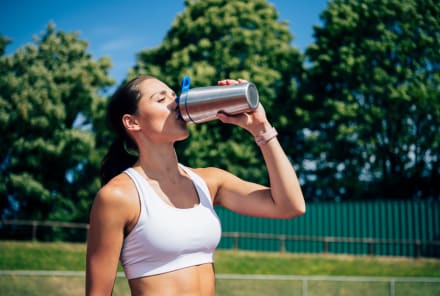Advertisement
This Vascular Biologist Wants You To Address Blood Vessel Health ASAP


If there's anything we've gained in the past year (other than a vast collection of face masks), it's an understanding that COVID-19 is far more than your typical respiratory virus.
Sure, some people have minor cold-like symptoms and go on their merry way. But others experience symptoms like "COVID toe" (red, swollen toes), headaches, body aches, brain fog, fatigue, vision problems, blood clots, kidney and liver issues, and more—sometimes for months after they've recovered from their initial acute infection. What's even more concerning is that some of these "long-COVID" or "long-haul COVID"1 symptoms can actually crop up after a pretty mild bout of the virus, catching people totally off-guard.
It's perplexing and scary. And while there's still so much we don't know, experts believe many of these diverse and widespread symptoms can at least partially be explained by COVID's effect on our body's vast 60,000-mile network of blood vessels—our vascular system.
Here, we tap the minds of top experts to find out exactly what's going on and what you can do.
What COVID-19 can do to your blood vessels and why it matters.
Last spring (i.e., the early days), vascular biologist and physician William W. Li, M.D., was intrigued by the ever-growing collection of strange and widespread COVID symptoms. It got him thinking: "Because blood vessels are a common denominator across all of the body and organs, could these symptoms all be due to a vascular problem?" Turns out, he was on to something.
Shortly after, Li and a group of international researchers performed autopsies on the lungs of COVID-19 victims and made a key discovery2: Not only was the virus causing damage to the lung tissue—which is typical of respiratory viruses—but it was also directly invading and damaging the endothelial cells that line the smallest blood vessels (i.e., microvessels or capillaries) of the lungs, and causing many tiny blood clots as a result.
Li compares this blood vessel damage to an ice rink before and after a hockey game: The lining of healthy vessels is like a perfectly smooth ice rink where the puck glides effortlessly. But when COVID damages vessels, it essentially shreds their lining, making them resemble the scuffed-up ice after a hockey game. "Blood flow slows, and things tend to stick to the walls and clot," he says.
The implications of this aren't great. "When we saw the first pictures of that little spiked ball penetrating blood vessel cells, it sent a chill down my spine," says Li. Because the virus can infect blood vessels, and because blood vessels supply oxygen and nutrients to every cell in the body, this means you can potentially experience COVID-induced microvascular damage anywhere—from your brain to your toes. And research suggests this damage doesn't always resolve quickly, which is why Li believes it's a major contributor to long-haul COVID symptoms, including brain fog, impaired vision, and organ damage.
Take brain fog (or myalgic encephalomyelitis), for example, which is estimated to affect around 52% of people with long-COVID symptoms. In a recent paper published in the 3NEJM3, researchers performed imaging studies and discovered that blood vessels leading to the brain of COVID patients were often damaged and essentially "leaking," which could be what's contributing to the fatigue and mental confusion associated with brain fog.
So, is everyone at equal risk of COVID-induced vascular damage?
Probably not. We already know that people with certain underlying medical conditions4 are at greater risk for severe illness and death from COVID-19. And while more research is needed, some experts believe preexisting conditions that already tax and inflame the blood vessels can essentially prime you for greater vascular damage if you get COVID-19. "We are really worried that people who already have weakened, vulnerable blood vessels are at even greater risk for long-term COVID," says Li.
Other experts agree. "It's very likely that people who already have trouble with their blood vessels will have more trouble with COVID-19," says John P. Cooke, M.D., Ph.D., chair of the Department of Cardiovascular Sciences at the Houston Methodist Research Institute and Science Advisory Board Member for Humann. That's why it's so important to try to prevent or treat conditions like high blood sugar, high cholesterol, and high blood pressure before you get COVID-19, he explains—since reversing these conditions will help improve blood vessel function.
But because many systems are at play with a COVID-19 infection, experts can't say with certainty who's at greatest risk for vascular damage or long-COVID symptoms—especially since some otherwise healthy people in their 20s and 30s have experienced these issues, says Li.
Can boosting vascular health now reduce your risk of COVID complications later?
Maybe! (Don't hate us for being noncommittal; we need more research.)
"There is no evidence to support this directly; however, there is indirect evidence to support the concept," says Cooke. "Vascular damage [in general] can be repaired, and we know that treatment of risk factors such as high blood pressure, diabetes, high cholesterol, and smoking allows the vascular system to improve." Cooke also believes some of the vascular damage inflicted by COVID-19 will improve with diet and lifestyle changes that support the blood vessels.
Similarly, Li thinks we should be doing everything we reasonably can to support vascular health, especially now. "The stronger your circulation and vascular health is, the more likely you are to get through any illness without a vascular problem," he says.
Plus, good circulation supports good immune health, too. "In order for your immune system to do its job, you need to have a really good circulation to carry those immune cells where they need to be," says Li.
7 diet and lifestyle tips to boost circulation and overall vascular health.
According to Li, who also wrote the bestseller Eat To Beat Disease, there are simple things we can do with food and lifestyle to reduce chronic inflammation, boost circulation, and repair and regenerate blood vessels—which may not be a magic bullet but certainly can't hurt:
Try a Mediterranean-inspired diet.
"The Mediterranean diet has lots of fresh fruits and vegetables, beans and legumes, and herbs—all of which are a treasure chest of natural plant chemicals that can help improve our body's health defense systems, including our circulation," says Li. Plus, research suggests the Mediterranean diet can help reduce inflammation5, improve cholesterol and blood pressure, and protect against stroke and peripheral vascular disease.
Dial up your phytochemical intake.
Certain plant foods contain key blood-vessel-nourishing phytochemicals, according to Li:
- Ursolic acid, found in the peels of fruits like apples, grapes, cherries, cranberries, and blueberries, can help repair damaged blood vessels and grow new ones.
- Quercetin—found in capers, red onions, citrus, berries, plums, apples, and more nutritious foods—can stimulate blood vessel growth and may help prevent the oxidation of LDL cholesterol.
- Flavonols in dark chocolate actually mobilize our body's own stem cells to help repair and grow new blood vessels and dramatically improve blood flow.
Get a dose of nitric oxide.
Nitric oxide helps improve blood flow, relax blood vessels, and reduce blood pressure—all great for vascular health. Garlic contains sulfur compounds, including allicin, that are thought to boost nitric oxide levels in the bloodstream (which is why it's been shown to lower blood pressure6), and beets contain dietary nitrates7 that are converted to nitric oxide in the body, too.
Load up on healthy fats.
The healthy omega-3 fats found in walnuts, chia seeds, flaxseeds, and fatty fish like salmon and sardines are great for keeping your blood vessels nice and supple—and they can help reduce the damage caused by vascular inflammation and atherosclerosis. Omega-3s have also been shown to reduce platelet aggregation (clumping), which may reduce the risk of clots.
Move your body every day.
Exercise is a no-brainer for boosting blood flow and keeping blood vessels supple and flexible (rigid blood vessels = bad). And, because working muscles need more blood than sedentary ones, exercise actually prompts your body to grow more blood vessels.
Not so mobile? Take regular baths.
Recent research, examining data from over 30,000 adults, suggested that taking. regular baths reduced the risk of developing cardiovascular disease by 28% and the risk of stroke by 26%. Researchers believe that's because the heat from the water boosts blood flow, and may help improve long-term vascular function.
Avoid going down a stress spiral.
The increased heart rate, elevated blood pressure, and high levels of stress hormones that accompany stress can take a toll on your heart and blood vessels by increasing vascular inflammation and upping risk for heart attack and stroke, according to the American Psychological Association. All the more reason to take a bath!
Bottom line.
Scientists are just beginning to unpack and understand the widespread effects of COVID-19 on the vascular system—and how those, in turn, play a role in persistent symptoms for some people. And while there's no magical way to prevent or cure this damage just yet (rest assured, Biotech companies are working on that, says Li), taking steps to curb your risk factors and optimize circulation and vascular health can only help.
7 Sources
- https://www.cdc.gov/coronavirus/2019-ncov/long-term-effects.html
- https://www.nejm.org/doi/full/10.1056/NEJMoa2015432
- https://www.nejm.org/doi/full/10.1056/NEJMc2033369
- https://www.cdc.gov/coronavirus/2019-ncov/need-extra-precautions/people-with-medical-conditions.html
- https://www.ncbi.nlm.nih.gov/pmc/articles/PMC6801699/
- https://pubmed.ncbi.nlm.nih.gov/25525386/
- https://www.ncbi.nlm.nih.gov/pmc/articles/PMC4425174/
Watch Next
Enjoy some of our favorite clips from classes
Enjoy some of our favorite clips from classes
What Is Meditation?
Mindfulness/Spirituality | Light Watkins
Box Breathing
Mindfulness/Spirituality | Gwen Dittmar
What Breathwork Can Address
Mindfulness/Spirituality | Gwen Dittmar
The 8 Limbs of Yoga - What is Asana?
Yoga | Caley Alyssa
Two Standing Postures to Open Up Tight Hips
Yoga | Caley Alyssa
How Plants Can Optimize Athletic Performance
Nutrition | Rich Roll
What to Eat Before a Workout
Nutrition | Rich Roll
How Ayurveda Helps Us Navigate Modern Life
Nutrition | Sahara Rose
Messages About Love & Relationships
Love & Relationships | Esther Perel
Love Languages
Love & Relationships | Esther Perel
What Is Meditation?
Box Breathing
What Breathwork Can Address
The 8 Limbs of Yoga - What is Asana?
Two Standing Postures to Open Up Tight Hips
How Plants Can Optimize Athletic Performance
What to Eat Before a Workout
How Ayurveda Helps Us Navigate Modern Life
Messages About Love & Relationships
Love Languages
Advertisement

This Type Of Fat Is Vital For Women's Health — Are You Getting Enough?
Molly Knudsen, M.S., RDN

New Study Confirms The 3 Habits That Age Your Brain Faster
Molly Knudsen, M.S., RDN

This Type Of Fat Is Vital For Women's Health — Are You Getting Enough?
Molly Knudsen, M.S., RDN

New Study Confirms The 3 Habits That Age Your Brain Faster
Molly Knudsen, M.S., RDN













